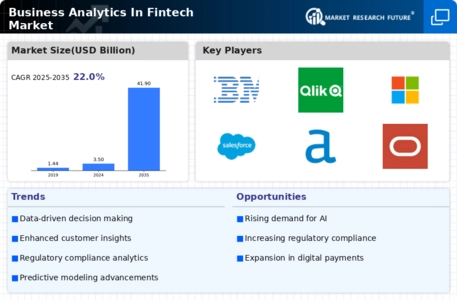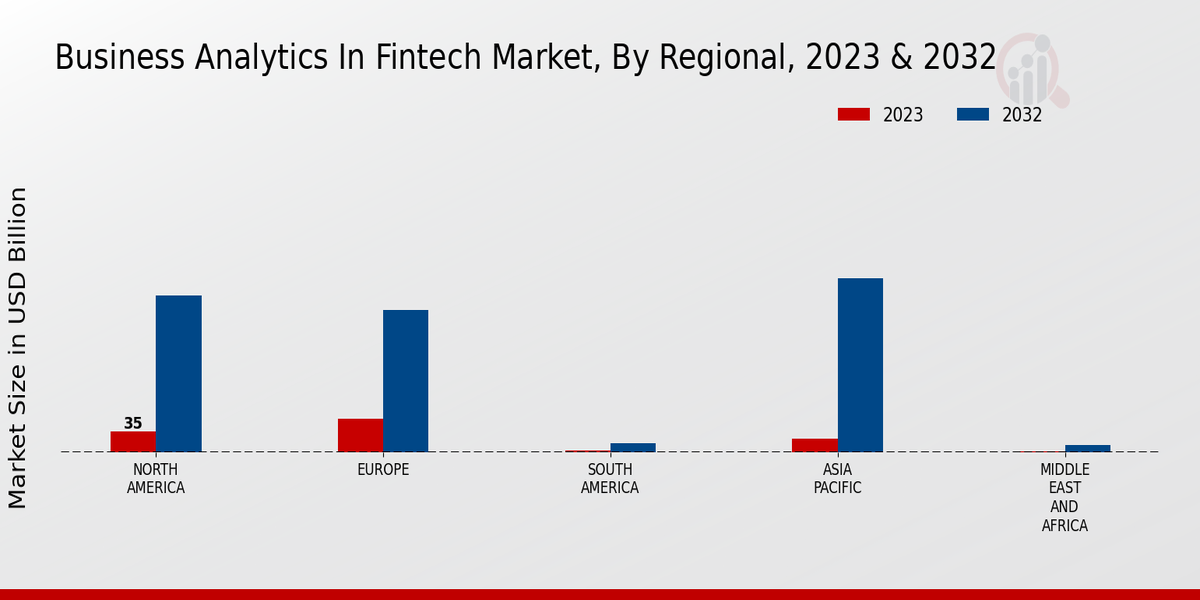Market Growth Projections
The Global Business Analytics In Fintech Market Industry is poised for substantial growth, with projections indicating a rise from 3.5 USD Billion in 2024 to 41.9 USD Billion by 2035. This trajectory suggests a compound annual growth rate of 25.33% from 2025 to 2035, reflecting the increasing integration of analytics in financial services. The growth may be attributed to various factors, including technological advancements, regulatory pressures, and evolving consumer expectations. As organizations continue to prioritize data-driven strategies, the market is likely to expand significantly, highlighting the critical role of analytics in shaping the future of fintech.
Growing Adoption of Cloud-Based Solutions
The shift towards cloud-based solutions is reshaping the Global Business Analytics In Fintech Market Industry, as organizations seek scalable and cost-effective analytics platforms. Cloud computing facilitates real-time data access and collaboration, enabling financial institutions to harness analytics without significant infrastructure investments. This trend is evident as more firms migrate to cloud environments, enhancing their analytical capabilities. The market's growth trajectory, from 3.5 USD Billion in 2024 to an estimated 41.9 USD Billion by 2035, highlights the transformative impact of cloud technology on analytics in the fintech sector.
Regulatory Compliance and Risk Management
Regulatory compliance remains a pivotal driver within the Global Business Analytics In Fintech Market Industry, as financial entities navigate complex regulatory landscapes. Analytics tools assist organizations in monitoring compliance and managing risks effectively. For example, advanced analytics can identify potential fraud patterns and ensure adherence to anti-money laundering regulations. As regulatory scrutiny intensifies, the demand for analytics solutions is likely to grow, contributing to the market's expansion. The anticipated growth from 3.5 USD Billion in 2024 to 41.9 USD Billion by 2035 underscores the critical role of analytics in fostering compliance and risk management.
Increasing Demand for Data-Driven Insights
The Global Business Analytics In Fintech Market Industry experiences a surge in demand for data-driven insights as financial institutions seek to enhance decision-making processes. Organizations are increasingly leveraging analytics to gain a competitive edge, optimize operations, and improve customer experiences. For instance, banks utilize predictive analytics to assess credit risk and personalize offerings. This trend is reflected in the projected market size, which is expected to reach 3.5 USD Billion in 2024, indicating a robust growth trajectory as firms recognize the value of data in shaping strategic initiatives.
Technological Advancements in Analytics Tools
Technological advancements significantly influence the Global Business Analytics In Fintech Market Industry, as innovations in artificial intelligence and machine learning enhance analytical capabilities. These technologies enable financial institutions to process vast amounts of data efficiently, uncovering insights that were previously unattainable. For instance, AI-driven algorithms can analyze customer behavior in real-time, allowing for tailored financial products. The integration of such technologies is expected to propel the market's growth, with a compound annual growth rate of 25.33% projected from 2025 to 2035, reflecting the increasing reliance on sophisticated analytics tools.
Rising Consumer Expectations for Personalization
Consumer expectations for personalized financial services are driving the Global Business Analytics In Fintech Market Industry. As customers demand tailored experiences, financial institutions are increasingly utilizing analytics to understand preferences and behaviors. For example, analytics can segment customers based on spending habits, enabling targeted marketing strategies. This shift towards personalization is likely to accelerate market growth, as organizations recognize the necessity of adapting to evolving consumer demands. The anticipated increase in market size from 3.5 USD Billion in 2024 to 41.9 USD Billion by 2035 illustrates the importance of analytics in meeting these expectations.





















Leave a Comment